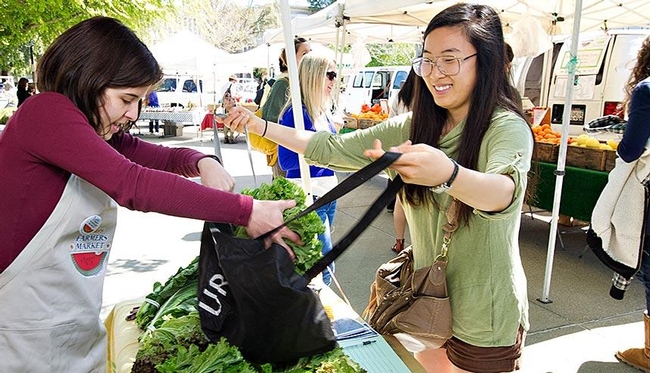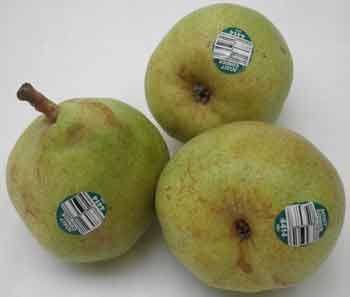Posts Tagged: Markets
Direct-marketing farms have double the regional impact
Sacramento-area farmers and ranchers who sell their products directly to consumers generate twice as much regional economic impact per dollar of output as do area food producers who don't engage in direct marketing, reports a UC Davis agricultural economist and a team of UC Cooperative Extension researchers.
The newly released study of the four Sacramento region counties of El Dorado, Placer, Sacramento and Yolo found that direct-marketing food producers had a regional output multiplier of 1.86 compared to just 1.42 for producers not involved in direct marketing.
Direct-marketing channels include farmers markets, roadside farm stands and community-supported agriculture programs that provide consumers with regular deliveries of farm products.
“The direct marketers make up a relatively small part of the Sacramento region's agricultural sector, but this study demonstrates that these food producers generate both economic and qualitative benefits for the region,” said study leader Shermain Hardesty, a UC Cooperative Extension specialist in the UC Davis Department of Agricultural and Resource Economics.
“It's important that the economic contributions of direct-marketing farmers and ranchers be taken into consideration so that regional policies can be enhanced to support and nurture the growth of these food producers,” Hardesty said.
The regional economic impacts identified in the study are threefold: revenue received directly by the agricultural producer; a ripple effect when the food producer purchases inputs in the region; and a secondary ripple when the producer and the suppliers of goods and services to the producer, in turn, spend more money in the region on household goods and services.
The report, along with separate economic impact reports specifically for El Dorado, Placer and Yolo counties, is available online.
Sacramento region direct marketers
In the four-county Sacramento region, direct-marketing food producers are a relatively small segment of the total agricultural sector, accounting for 19 percent of the region's farms and only 4 percent of its agricultural production.
The direct-marketing farm operations tend to be smaller and more labor-intensive, and source more of their inputs locally than do nondirect-marketing operations in the area.
The new study was based on economic information gathered from 88 local farmers and ranchers, including 31 vegetable farmers, 48 orchard or vineyard growers and nine livestock producers, each of whom generated at least $1,000 in annual sales from marketing directly to consumers.
After the data were collected, they were incorporated into an economic modeling program to estimate the economic impacts of producers engaged in direct marketing.
Study highlights
Other findings from the report include:
• Sacramento region direct-market producers averaged just $164,631 in one year of sales compared to $568,105 for those not engaged in direct marketing.
• Seventy-three percent of the direct marketers also sold through wholesale channels.
• Overall, the direct-market producers generated 44 percent of their total revenues through direct-marketing channels, 55 percent through wholesale channels and 1 percent through commodity markets.
• For every $1 million of output, the direct-market producers generated a total of 31.8 jobs in the Sacramento region while the nondirect-market producers generated only 10.5 jobs.
• Direct marketers purchased 89 percent of their inputs within the region while the nondirect-market producers purchased 45 percent of their inputs in the region. This local sourcing of inputs was the primary factor responsible for the direct-market producers having a greater economic impact on the region than nondirect-market producers.
Collaborators and funding
Hardesty collaborated on the study with Libby Christensen, Erin McGuire and Gail Feenstra, all of UC Davis; and Chuck Ingels, Jim Muck, Julia Boorinakis-Harper, Cindy Fake and Scott Oneto, all with the UC Cooperative Extension.
Funding for the study was provided by the University of California Division of Agriculture and Natural Resources Competitive Grants Program.
International trade important to California agricuture
The vice president of UC Agriculture and Natural Resources, Glenda Humiston, was a speaker at the summit. She said UC has calculated that 1.2 million California jobs are tied to the state's natural resources - including agriculture, fishing, mining, recreation and renewable energy. Humiston predicted there will be 300,000 more jobs in this sector over the next five years.
However, the pool of workers for the jobs is diminishing because young people in Mexico and Central America, who often fill these positions, are increasingly able to find better paying, less taxing jobs elsewhere.
"There's going to be massive upheavals in the system," Humiston said.
The article noted that nearly every industry leader at the summit stressed the importance to California agriculture of the Trans-Pacific Partnership, a trade deal involving the U.S. and 11 other Pacific Rim nations.
Workshops aim to boost local and regional food businesses with federal grants
The workshops are designed to help potential applicants understand, develop and submit federal grant applications for the Farmers Market and Local Food Promotion programs. The 2014 Farm Bill reauthorized this program, which will provide $30 million in grants each year through 2018. The funds will be divided between the Farmers Market Promotion Program and the Local Food Promotion Program.
The workshop instructor is Jennifer Sowerwine, a UC ANR specialist based at UC Berkeley whose research and extension is focused on development of equitable, economically viable and culturally relevant food systems in metropolitan areas.
“The workshop is open to anyone interested in connecting agricultural producers and consumers through local food systems,” Sowerwine said. “This is a great opportunity to strengthen the local economy, support small-scale farmers, and make fresh, healthy food more accessible to the community.”
The workshops are a collaborative effort involving UC ANR, USDA and Regional Rural Development Centers. They will run from 9 a.m. to 2 p.m. as follows:
April 8 - Berkeley. 155 Kroeber Hall at UC Berkeley
April 10 - Modesto. Stanislaus County Ag Center, 3800 Cornucopia Way, Modesto
April 15 - Davis. UC ANR Building, 2801 Second St., Davis
April 22 - Redding. North Valley Catholic Social Services, 2400 Washington Ave., Redding
Each of the workshops will provide an overview of the grant programs and help in developing project ideas, preparing the proposal and completing the application. All applications much be submitted by 11:59 p.m. Eastern May 14. Sowerwine suggests applicants start the application process as soon as possible to ensure they meet the deadline. To apply, go to http://www.grants.gov. Questions about the process will be addressed at the workshop.
Registration is $10 and includes lunch, training materials and resources. The agenda, details and online registration are on the web at http://ucanr.edu/sites/localfoodpromo. For more information about the program, contact Jennifer Sowerwine at (510) 664-7043, jsowerwi@berkeley.edu. For information about workshop logistics, contact Alex Zabelin, (530) 750-1259, or Saundra Wais, (530) 750-1260, or email anrprogramsupport@ucanr.edu.
The University of California Global Food Initiative aims to put the world on a path to sustainably and nutritiously feed itself. By building on existing efforts and creating new collaborations among UC's 10 campuses, affiliated national laboratories and the Division of Agriculture and Natural Resources, the initiative will develop and export solutions for food security, health and sustainability throughout California, the United States and the world.
Farmers market prices compare well with the supermarket produce aisle
Many shoppers believe they can buy cheaper produce at supermarkets than at local farmers markets. A new UC Cooperative Extension study dispels that common misperception.
In Placer and Nevada counties, UCCE received a CDFA Specialty Block Grant to encourage consumers to eat more fruits and vegetables and support the local agricultural industry by buying the produce from them. The project led to the creation of the “Eat Local Placer Nevada” campaign.
“Buying locally grown products supports local farmers and ranchers and it keeps land in agriculture,” said Cindy Fake, UCCE farm advisor in Placer and Nevada counties. “Simply put, it's the right thing to do.”
To give consumers extra incentive to eat local, the group launched a seven-month study to compare prices at farmers markets and grocery stores. Volunteers and staff collected price data at four farmers markets and six grocery stores from January to July 2014. Specials and sale items were not part of the study. The data suggests that organic produce at farmers markets is priced about the same as organic produce at grocery stores.
In terms of conventional produce, grocery stores had cheaper prices on 6 out of 11 items; however, consumers would still save money picking up red apples, beets and chard at the farmers markets. The cost of conventional butternut squash and sweet potatoes was virtually equal at the two venues.
“Contrary to many consumers' perception, farmers market prices are competitive with regular supermarket prices,” Fake said. “Some prices are slightly higher, some slightly lower, but they are in the same range. “
However, there are other factors shoppers should keep in mind when deciding to buy supermarket produce or fruit and vegetables grown by their neighboring farmers.
“Produce at the farmers market is sold the same day or the day after it is harvested,” Fake said. “Because of that, its shelf life is two to three times longer than what is found in the supermarket. And because it is so fresh, you have a higher nutrient content and it will taste better.”
Fake said experts believe buying local also supports the local economy. She is collaborating on a project led by Shermain Hardesty, UCCE specialist in the Department of Agricultural and Resource Economics at UC Davis, to document the economic impact of local food systems in Placer, El Dorado, Sacramento and Yolo counties. The researchers will gather data about farmers' purchases of inputs and local sales of produce.
“This project will provide science-based evidence to guide public policy and program design aimed at supporting local farmers and local food systems into the future,” Fake said.
The study – titled Measuring the Impact of Local Food Marketing on the Local Economy – is supported with a $226,048 grant from the UC Division of Agriculture and Natural Resources.
California's delicious harvest season unfolds
Early spring can be an invigorating time of year, with lengthening days, blooming daffodils and fruit trees (and ski season still in full force). One of the best perks of the season is the availability of luscious strawberries, and tasty artichokes and asparagus picked from nearby farms, with flavor quality and price that reflects both in-season and local transportation benefits.
Depending on your location, farmers markets and pick-your-own farms will begin offering their wares within the next month or two. There are over 700 farmers markets in California. A wide variety of produce, from the exotic to the humble every-day variety, is available to entice you with its fresh beauty. We here in the West spend more annually on fresh produce at $511 vs. the national average of $429, wrote Roberta Cook, UC Cooperative Extension specialist in the UC Davis Department of Agriculture and Resource Economics, in “Eye on Economics: Much more than Dollars and Cents. Cook states that, “California produces half of the nation’s fresh fruits and vegetables and consumers here are privileged to have an abundance of high quality fresh produce over extended seasons due to California’s Mediterranean climate.”
Elsewhere in the United States “local” food markets are much less developed due to climate restrictions that limit production to a brief period in the summer and early fall; and the variety of products grown is only a fraction of the over 200 crops grown in California. While “local” production represents a rapidly growing share of U.S. agricultural sales, with direct-to-consumer sales more than quadrupling in the past decade, outside of California the share is still tiny.
There are few things as disappointing as biting into a piece of fruit that looks beautiful on the outside but just doesn’t deliver that burst of flavor, or cutting into a nice-looking vegetable only to find an unsightly defect inside. When I’m prowling through a display of fresh produce, I rev up all my senses into high gear and get up-close and personal with the fruit and veggie items on my list. I get busy feeling the weight-to-size ratio, gently (not too hard, mind you, or you’ll get a bad reputation with other shoppers) pressing to feel for firmness, looking at color, form, and stem separation area, and smelling the aroma. All of these things, and more, help provide clues about the quality inside.
Country of Origin Labeling (COOL) and Price Look Up (PLU) stickers
Other clues are often available about where and how your produce items were grown. For instance, in 2009 rules (affecting retail grocers) were adopted by the USDA mandating country of origin labeling (COOL), which required that retailers notify customers of the country of origin of all perishable agricultural commodities. Also offering insights into your produce selection is the Price Look Up sticker. Created by the Produce Marketing Association (PMA) in 1987 to create a standardized system to assist check-out clerks with looking up the produce items, it also indicates additional information such as whether it’s organic.
For instance, if your produce item’s sticker has a 4 digit code, it is “conventionally grown, but not organic.” If the code has 5 digits, and the first digit is a 9, the produce was organically grown. Usually the PLU stickers also include the country of origin in writing, but if not, this information should be displayed on the packing box or other store signage. Conventionally grown produce is recognized by scientists and regulators to be just as safe as organically grown and there is no evidence that it is worse for the environment. About 95 percent of retail fresh produce sales are conventionally grown and generally cost about 30 percent less than organics.
There are a number of resources that can help produce shoppers improve their savvy shopping skills:
From the Farm to Your Table: A Consumer’s Guide to Fresh Fruits and Vegetables, by James Thompson and Adel Kader. This 16-page booklet offers information on measuring quality; farm-based growing conditions, practices and harvesting; handling, transportation and storage; and selecting and storing good-quality produce for use at home. The table on how to select good-quality produce is especially helpful. ($7.00/copy)
Shopping for Fruits & Vegetables at the Fruits and Veggies: More Matters web site
Storing Fresh Fruit and Vegetables for Better Taste, a free downloadable poster from the UC Davis Postharvest Technology Center
i know produce, a comprehensive produce website developed by the Produce Marketing Association (PMA) that includes photo identification, written description, availability by location, nutrition information, storage/handling, and tips.








